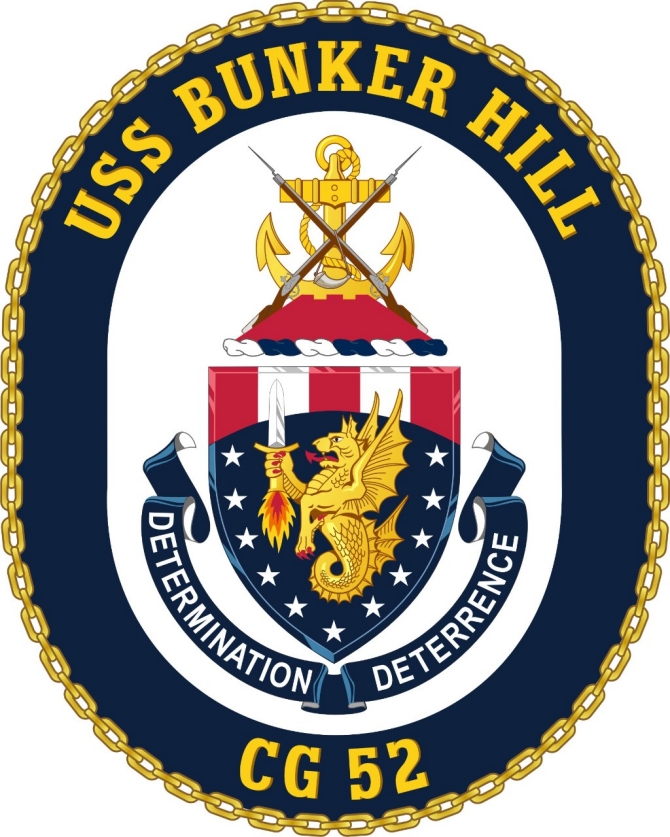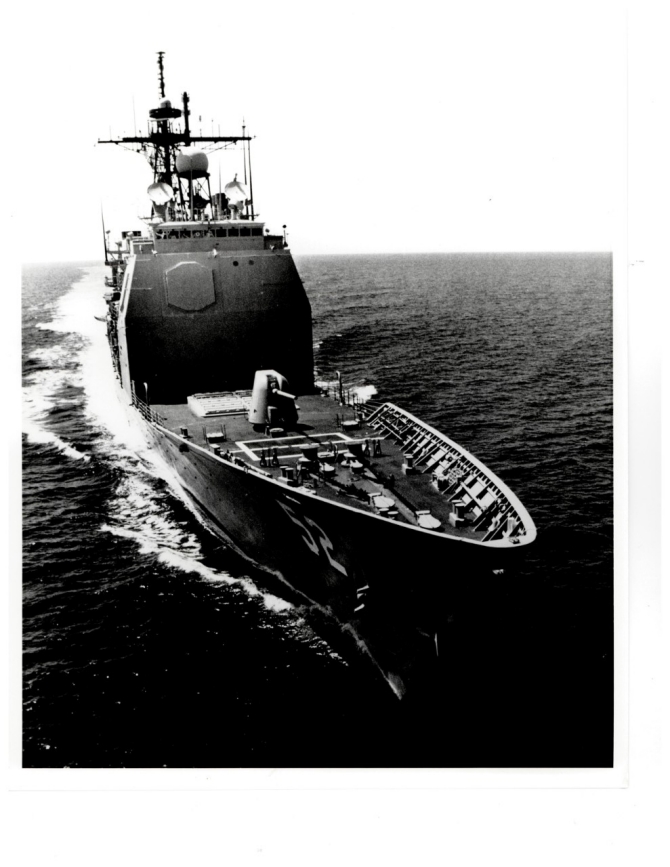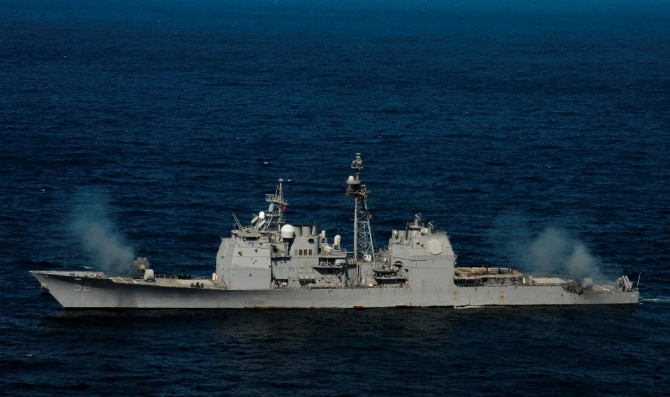Bunker Hill II (CG-52)
1986-2023
Bunker Hill is a height in Charlestown, Mass. The battle, that bears this name, was actually fought on 17 June 1775 on adjacent Breed’s Hill.
After she was acquired by the Navy on 12 November 1917 for service in World War I, coastal steamer Bunker Hill (Id. No. 1256) was converted to a minelayer and renamed Aroostook (http://www.history.navy.mil/danfs/a12/aroostook-ii.htm). The first Bunker Hill (CV-17), an aircraft carrier, served from 1943-1966 (http://www.history.navy.mil/danfs/b10/bunker%20hill-i.htm).
For the ship's Command Operations Reports see (http://www.history.navy.mil/research/archives/command-operations-reports/ships/b/bunker-hill-gc-52-ii.html).
II
(CG-52: displacement 9,600; length 567'; beam 55'; draft 33'; speed 30+ knots; complement 363; armament 2 5-inch, 2 Mk 41 Vertical Launch Systems (VLS) for BGM-109 Tomahawks, RIM-66 SM-2MR Standards, and RUM-139 VL-ASROC Antisubmarine Rockets, 8 RGM-84 Harpoon anti-ship missile canister launchers, 2 Mk 15 Close In Weapon Systems (CIWS), 4 .50 caliber machine guns, and 6 Mk 32 torpedo tubes, aircraft 2 Sikorsky SH-60B Light Airborne Multi-Purpose System (LAMPS) Mk III Seahawks; class Ticonderoga)
The second Bunker Hill (CG-52) was laid down on 11 January 1984 at Pascagoula, Miss., by Ingalls Shipbuilding Division, Litton Industries; launched on 11 March 1985; sponsored by Mrs. Margaret Skallerup, wife of Walter T. Skallerup Jr., General Counsel to the Secretary of the Navy; and commissioned on 20 September 1986 at the Old Navy Yard, Charlestown, Mass., Capt. Philip M. Quast in command.

Shield
The sea dragon is a powerful beast that is both vigilant and fierce. Grasping a flaming sword, the sea dragon symbolizes naval prowess and the attack capability of Bunker Hill (CG-52). The flaming sword also represents the revolutionary capability of the ship’s Vertical Launching System. The stars represent the eleven battle stars that aircraft carrier Bunker Hill (CV-17) earned for her World War II service. Blue and gold are the colors traditionally associated with the Navy and are symbolic of the sea and excellence. The two white bars in chief represent American courage and purpose as displayed at the battle of Bunker Hill on 17 June 1775. The red bars symbolize the British assaults on the colonists’ positions, and the curve below alludes to the hill which the British captured at great cost. Bunker Hill proved to be a rallying point for the Americans, for after that the British Empire faced full scale war.
Crest
The entrenchments or redoubts the colonists dug and built are symbolized by the scarlet hill shape with battlements. The muskets with bayonets recall the weapons of that battle, and the powder horn refers to the New Englanders’ stand until they fired the last of their ammunition. The anchor symbolizes maritime tradition and excellence of achievement.

Lonewolf 40, an SH-60B Seahawk (BuNo 162134) of Helicopter Antisubmarine Squadron Light (HSL) 45 Detachment 1, Lt. Cmdr. Larry E. Larson, officer-in-charge, operated from Bunker Hill immediately following her commissioning.
Bunker Hill deployed for Operations Desert Shield and Desert Storm in 1990-91. Guided missile cruisers Bunker Hill, Mobile Bay (CG-53), and Worden (CG-18) formed what they called an antiair “cruiser line” across the northern gulf in January 1991. Up to five Iraqi aircraft flew from an airfield at al-Kut southeast of Baghdad for the Kuwaiti coast on 24 January. Two Dassault-Breguet F-1 Mirages continued southeast along the boundary between USAF and Navy radar coverage and penetrated into the screen surrounding ships that sailed in the Persian Gulf. A USAF Boeing E-3A Sentry Airborne Warning and Control System (AWACs) failed to notify Bunker Hill, Mobile Bay, and Worden by normal procedures and informed them by voice. McDonnell Douglas F/A-18A Hornets operating from aircraft carriers Midway and Theodore Roosevelt unsuccessfully attempted to intercept the intruders. The Sentry vectored four Saudi McDonnell Douglas F-15 Eagles, and Saudi Capt. Ayedh al-Shamrani shot down both Mirages with AIM-9 Sidewinder air-to-air missiles. The Iraqis had reached a point 60 nautical miles from Mobile Bay and within range to launch Aérospatiale AM.39 Exocet air-to-surface missiles at the cruiser. Communications and radar errors and inexperience led to a nearly calamitous encounter. Mobile Bay relieved Bunker Hill as the battle force’s antiair warfare commander on 14 February.
The People’s Republic of China test-launched short-ranged ballistic missiles and staged amphibious landings in proximity to Taiwan (21 July 1995-23 March 1996). The Chinese operations exacerbated the tensions in the region, and journalists dubbed the confrontation the “Third Taiwan Strait Crisis.” The Chinese fired additional missiles (7-15 March 1996), and the U.S. reinforced its forces in the Western Pacific. Detached from aircraft carrier Independence (CV-62) on 7 March, Bunker Hill steamed at high speed overnight to a position in the Taiwan Strait southeast of Taiwan, where she operated under the command of Task Force 72. The following day, Independence proceeded to a position northeast of Taiwan, from where her aircraft supported Bunker Hill and the other ships that monitored the crisis. Nimitz (CVN-68) also subsequently came about from the Arabian Gulf and made for an area nearby. Bunker Hill sailed from the area when the tensions eased on 25 March.
Two al-Qaeda terrorists brought an inflatable Zodiac-type speedboat that carried a bomb alongside Cole (DDG-67) while the guided missile destroyer refueled and detonated their lethal cargo, killing 17 sailors and wounding 42 more in Aden, Yemen, on 12 October 2000. Damage control efforts saved Cole. Vessels that responded included amphibious assault ship Tarawa (LHA-1), dock landing ship Anchorage (LSD-36), amphibious transport dock Duluth (LPD-6), guided missile destroyer Donald Cook (DDG-75), guided missile frigate Hawes (FFG-53), and tug Catawba (T-ATF-168), along with British frigates Cumberland (F.85) and Marlborough (F.233). Bunker Hill emergency sortied from Manama, Bahrain, and provided force protection and logistics support to some of these ships while serving as a guard ship (15 October-12 November) with mine countermeasures ships Ardent (MCM-12) and Dextrous (MCM-13), and minehunters Cardinal (MHC-60) and Raven (MHC-61). The Navy subsequently enhanced global force protection training during crucial transits, and sailors qualified to fire M60 and Browning M2 .50 caliber machine guns to defend against assaults by low-slow flying aircraft and small boats.
Bunker Hill deployed for Operation Iraqi Freedom I and on the night of 21 March 2003, she joined 29 other U.S. and British ships and submarines that fired BGM-109 Tomahawk Land Attack Missiles (TLAMs) against Iraqi military targets.
Ethiopian troops and Muslim extremists clashed in Somalia (winter 2006-2007). Allied intelligence analysts suspected some of these extremists of involvement in the terrorist bombing of the U.S. Embassies at Nairobi, Kenya, and Dar es Salaam, Tanzania, on 7 August 1998. On 7 January 2007, a USAF Lockheed AC-130 gunship therefore attacked al-Qaeda terrorist leaders at a Somali fishing village near Ras Kamboni on the Kenyan border. The following day, the Fifth Fleet moved aircraft carrier Dwight D. Eisenhower (CVN-69) toward Somali waters, which operated during the succeeding days with guided missile cruisers Bunker Hill and Anzio (CG-68), and dock landing ship Ashland (LSD-48), while they searched vessels for terrorists who attempted to escape from Somalia.
A magnitude 7.3 earthquake devastated Port-au-Prince, Haiti, on 12 January 2010, killing an estimated 230,000 people. The U.S. initiated Operation Unified Response—humanitarian aid to victims. At the peak level of Unified Response, 23 Navy ships participated including Bunker Hill, aircraft carrier Carl Vinson (CVN-70), with Carrier Air Wing (CVW) 17 embarked, amphibious assault ships Bataan (LHD-5) and Nassau (LHA-4), dock landing ships Ashland (LSD-48), Carter Hall (LSD-50), Fort McHenry (LSD-43), and Gunston Hall (LSD-44), and amphibious transport dock Mesa Verde (LPD-19), with the 22nd and 24th Marine Expeditionary Units embarked, together with 10 Coast Guard ships. A total of 264 U.S. fixed-wing aircraft took part, along with 57 helos and tiltrotor aircraft. The Air Force diverted a Northrop Grumman RQ-4A en route to Afghanistan and operated the Global Hawk on several reconnaissance missions over Haiti from NAS Patuxent River, Md. Airlifters of all the services and international aid agencies staged through NAS Jacksonville, Fla. Carl Vinson came about on 1 February and by 24 March these vessels largely sailed from Haitian waters, although relief efforts continued into the summer.

Detailed history under construction.
Robert J. Cressman and Mark L. Evans


